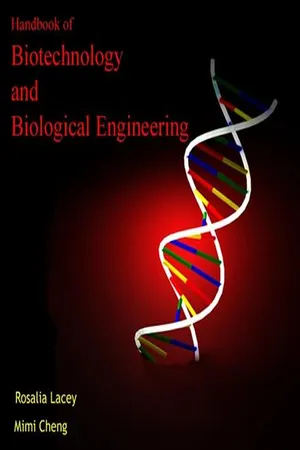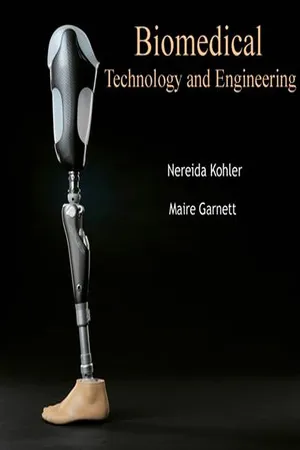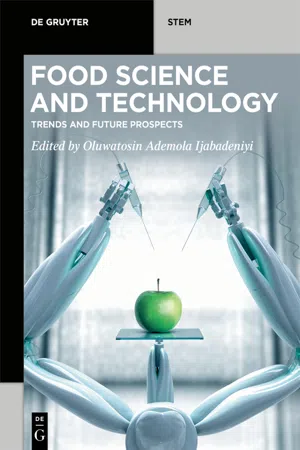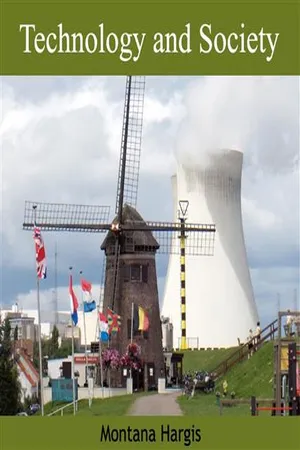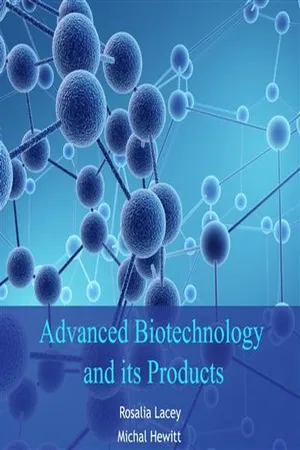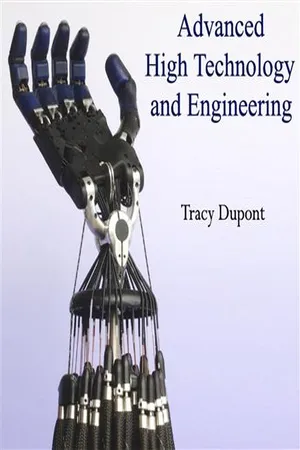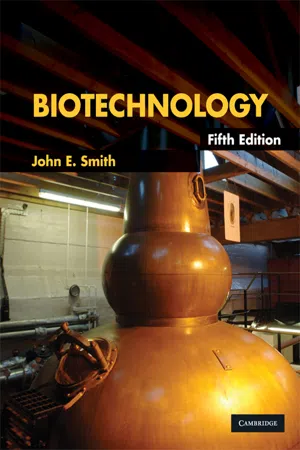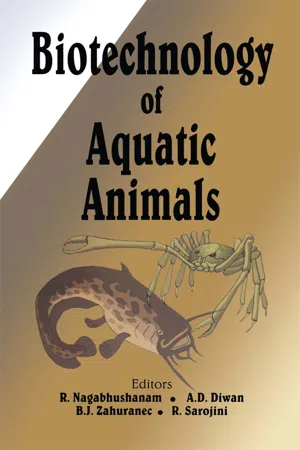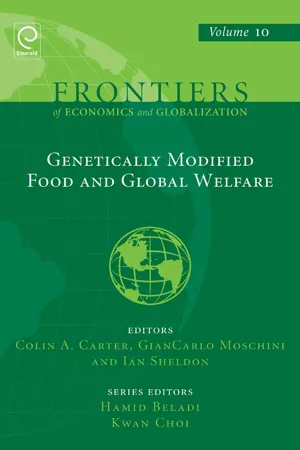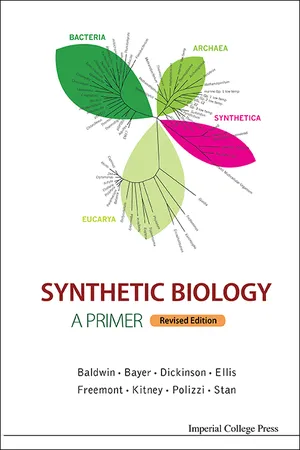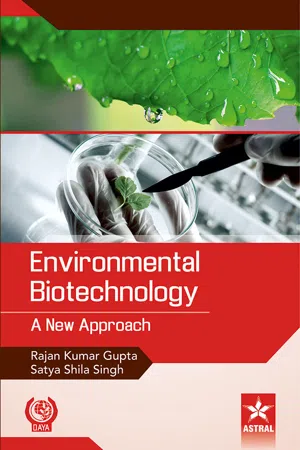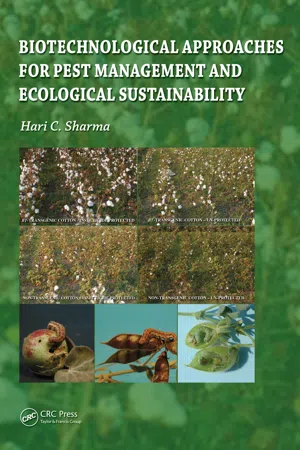Biological Sciences
Application of Biotechnology
The application of biotechnology involves using biological systems, organisms, or derivatives to develop products and technologies that benefit various industries, including agriculture, medicine, and environmental conservation. This can include genetic engineering, biopharmaceuticals, biofuels, and bioremediation. Biotechnology has the potential to address global challenges and improve human health, food security, and sustainability.
Written by Perlego with AI-assistance
Related key terms
1 of 5
12 Key excerpts on "Application of Biotechnology"
- No longer available |Learn more
- (Author)
- 2014(Publication Date)
- Academic Studio(Publisher)
The biotechnology sector has allowed the U.S. farming industry to rapidly increase its supply of corn and soybeans—the main inputs into biofuels—by developing genetically modified seeds which are resistant to pests and drought. By boosting farm productivity, biotechnology plays a crucial role in ensuring that biofuel production targets are met. Applications A rose plant that began as cells grown in a tissue culture Biotechnology has applications in four major industrial areas, including health care (medical), crop production and agriculture, non food (industrial) uses of crops and other products (e.g. biodegradable plastics, vegetable oil, biofuels), and environmental uses. ____________________ WORLD TECHNOLOGIES ____________________ For example, one Application of Biotechnology is the directed use of organisms for the manufacture of organic products (examples include beer and milk products). Another example is using naturally present bacteria by the mining industry in bioleaching. Biotechnology is also used to recycle, treat waste, clean up sites contaminated by industrial activities (bioremediation), and also to produce biological weapons. A series of derived terms have been coined to identify several branches of biotechnology, for example: • Bioinformatics is an interdisciplinary field which addresses biological problems using computational techniques, and makes the rapid organization and analysis of biological data possible. The field may also be referred to as computational biology , and can be defined as, conceptualizing biology in terms of molecules and then applying informatics techniques to understand and organize the information associated with these molecules, on a large scale. Bioinformatics plays a key role in various areas, such as functional genomics, structural genomics, and proteomics, and forms a key component in the biotechnology and pharmaceutical sector. - No longer available |Learn more
- (Author)
- 2014(Publication Date)
- College Publishing House(Publisher)
____________________ WORLD TECHNOLOGIES ____________________ Chapter 5 Biotechnology Insulin crystals Biotechnology is a field of applied biology that involves the use of living organisms and bioprocesses in engineering, technology, medicine and other fields requiring bioproducts. Biotechnology also utilizes these products for manufacturing purpose. Modern use of similar terms includes genetic engineering as well as cell- and tissue culture technologies. The concept encompasses a wide range of procedures (and history) for modifying living organisms according to human purposes - going back to domestication of animals, cultivation of plants, and improvements to these through breeding programs that employ artificial selection and hybridization. By comparison to biotechnology, bioengineering is generally thought of as a related field with its emphasis more on higher systems approaches (not necessarily altering or using biological materials directly ) for interfacing with and utilizing living things. The United Nations Convention on Biological Diversity defines biotechnology as: Any technological application that uses biological systems, living organisms, or derivatives thereof, to make or modify products or processes for specific use. In other term Application of scientific and technical advances in life science to develop commercial products is biotechnology. ____________________ WORLD TECHNOLOGIES ____________________ Biotechnology draws on the pure biological sciences (genetics, microbiology, animal cell culture, molecular biology, biochemistry, embryology, cell biology) and in many instances is also dependent on knowledge and methods from outside the sphere of biology (chemical engineering, bioprocess engineering, information technology, biorobotics). - eBook - PDF
Food Science and Technology
Trends and Future Prospects
- Oluwatosin Ademola Ijabadeniyi(Author)
- 2020(Publication Date)
- De Gruyter(Publisher)
Abimbola M. Enitan-Folami, Feroz M. Swalaha 10 Application of Biotechnology in the food industry 10.1 Introduction Biotechnology can be defined as any technological application that uses biological systems, living organisms, or derivatives to produce or modify products or pro-cesses for specific use (GBO report, 2007). Biotechnology integrates animal, human, and microorganisms that have contributed to every aspect of our lives. It has opened numerous opportunities to different sectors such as food technology, agri-culture, animal sciences, cell biology, plant sciences, environmental sciences, and medicine. For example, food technology is not only important but a promising re-search area that applies biotechnology tools to improve the oldest food processing techniques such as fermentation, enzyme production, as well as conservation of plants (Yu, 2017). Food processing as an aspect of biotechnology targets the selection and im-provement of microbes. The essence is to improve the process of enhancing effi-ciency, quality, safety, and consistency of bioprocessed products (Pal, 2017). The process uses various biotechnological tools and technologies to transform perish-able raw ingredients or inedible raw food materials into more palatable foods, use-ful shelf stable with long shelf life and potable beverages (Maryam et al., 2017). Through the use of modern biotechnology in the food industry, reduction of food losses has not only made possible, but the efficiency of food quality has also been improved. Food biotechnology overlaps with genetic engineering in the food industry be-cause genes in food sources like animals, plants, and microorganisms are modified to create new species of animals and plants (Pal, 2017). Similarly, genetic engineer-ing also employs biotechnological tools to convert ingredients in food to other mar-ketable and attractive value-added products that are cost-effective, safe, nutritious, and healthy to support human health. - No longer available |Learn more
- (Author)
- 2014(Publication Date)
- Orange Apple(Publisher)
________________________ WORLD TECHNOLOGIES ________________________ Chapter- 7 Biotechnology Insulin crystals Biotechnology is a field of applied biology that involves the use of living organisms and bioprocesses in engineering, technology, medicine and other fields requiring bioproducts. Modern use of similar terms includes genetic engineering as well as cell- and tissue culture technologies. The concept encompasses a wide range of procedures (and history) for modifying living organisms according to human purposes - going back to domestication of animals, cultivation of plants, and improvements to these through breeding programs that employ artificial selection and hybridization. By comparison to biotechnology, bioengineering is generally thought of as a related field with its emphasis more on higher systems approaches (not necessarily altering or using biological materials directly ) for interfacing with and utilizing living things. The United Nations Convention on Biological Diversity defines biotechnology as: Any technological application that uses biological systems, living organisms, or derivatives thereof, to make or modify products or processes for specific use. Biotechnology draws on the pure biological sciences (genetics, microbiology, animal cell culture, molecular biology, biochemistry, embryology, cell biology) and in many instances is also dependent on knowledge and methods from outside the sphere of biology (chemical engineering, bioprocess engineering, information technology, bioro- ________________________ WORLD TECHNOLOGIES ________________________ botics). Conversely, modern biological sciences (including even concepts such as molecular ecology) are intimately entwined and dependent on the methods developed through biotechnology and what is commonly thought of as the life sciences industry. - No longer available |Learn more
- (Author)
- 2014(Publication Date)
- College Publishing House(Publisher)
By boosting farm productivity, biotechnology plays a crucial role in ensuring that biofuel production targets are met. Applications A rose plant that began as cells grown in a tissue culture WT ____________________ WORLD TECHNOLOGIES ____________________ Biotechnology has applications in four major industrial areas, including health care (medical), crop production and agriculture, non food (industrial) uses of crops and other products (e.g. biodegradable plastics, vegetable oil, biofuels), and environmental uses. For example, one Application of Biotechnology is the directed use of organisms for the manufacture of organic products (examples include beer and milk products). Another example is using naturally present bacteria by the mining industry in bioleaching. Biotechnology is also used to recycle, treat waste, clean up sites contaminated by industrial activities (bioremediation), and also to produce biological weapons. A series of derived terms have been coined to identify several branches of biotechnology, for example: • Bioinformatics is an interdisciplinary field which addresses biological problems using computational techniques, and makes the rapid organization and analysis of biological data possible. The field may also be referred to as computational biology , and can be defined as, conceptualizing biology in terms of molecules and then applying informatics techniques to understand and organize the information associated with these molecules, on a large scale. Bioinformatics plays a key role in various areas, such as functional genomics, structural genomics, and proteomics, and forms a key component in the biotechnology and pharmaceutical sector. • Blue biotechnology is a term that has been used to describe the marine and aquatic applications of biotechnology, but its use is relatively rare. • Green biotechnology is biotechnology applied to agricultural processes. An example would be the selection and domestication of plants via micropropagation. - No longer available |Learn more
- (Author)
- 2014(Publication Date)
- Library Press(Publisher)
________________________ WORLD TECHNOLOGIES ________________________ Chapter- 3 Biotechnology Insulin crystals Biotechnology is a field of applied biology that involves the use of living organisms and bioprocesses in engineering, technology, medicine and other fields requiring bioproducts. Modern use of similar terms includes genetic engineering as well as cell- and tissue culture technologies. The concept encompasses a wide range of procedures (and history) for modifying living organisms according to human purposes - going back to dome-stication of animals, cultivation of plants, and improvements to these through breeding programs that employ artificial selection and hybridization. By comparison to biotechnology, bioengineering is generally thought of as a related field with its emphasis more on higher systems approaches (not necessarily altering or using biological materials directly ) for interfacing with and utilizing living things. The United Nations Convention on Biological Diversity defines biotechnology as: Any technological application that uses biological systems, living organisms, or derivatives thereof, to make or modify products or processes for specific use. Biotechnology draws on the pure biological sciences (genetics, microbiology, animal cell culture, molecular biology, biochemistry, embryology, cell biology) and in many instances is also dependent on knowledge and methods from outside the sphere of biology (chemical engineering, bioprocess engineering, information technology, bio-robotics). Conversely, modern biological sciences (including even concepts such as ________________________ WORLD TECHNOLOGIES ________________________ molecular ecology) are intimately entwined and dependent on the methods developed through biotechnology and what is commonly thought of as the life sciences industry. - eBook - PDF
- John E. Smith(Author)
- 2009(Publication Date)
- Cambridge University Press(Publisher)
The European Federation of Biotechnology (EFB) considers biotechnol-ogy as ‘the integration of natural sciences and organisms, cells, parts thereof, and molecular analogues for products and services’. The aims of this federation are: (1) to advance biotechnology for the public benefit (2) to promote awareness, communication and collaboration in all fields of biotechnology 1.2 WHAT IS BIOTECHNOLOGY? 3 Table 1.1 Some selected definitions of biotechnology A collective noun for the application of biological organisms, systems or processes to manufacturing and service industries. The integrated use of biochemistry, microbiology and engineering sciences in order to achieve technological (industrial) application capabilities of microorganisms, cultured tissue cells and parts thereof. A technology using biological phenomena for copying and manufacturing various kinds of useful substances. The application of scientific and engineering principles to the processing of materials by biological agents to provide goods and services. The science of the production processes based on the action of microorganisms and their active components and of production processes involving the use of cells and tissues from higher organisms. Medical technology, agriculture and traditional crop breeding are not generally regarded as biotechnology. Really no more than a name given to a set of techniques and processes. The use of living organisms and their components in agriculture, food and other industrial processes. The deciphering and use of biological knowledge. The application of our knowledge and understanding of biology to meet practical needs. (3) to provide governmental and supranational bodies with information and informed opinions on biotechnology (4) to promote public understanding of biotechnology. The EFB definition is applicable to both ‘traditional or old’ and ‘new or modern’ biotechnology. - eBook - PDF
- R Nagabhushanam, A.D. Diwan, B.J. Zahurne, R Nagabhushanam(Authors)
- 2004(Publication Date)
- CRC Press(Publisher)
Chapter 1 BIOTECHNOLOGY : USES AND APPLICATIONS R. Nagabhushanam and R. Sarojini Biotechnology is a scientific discipline based on the ability of scientists to transfer specific units of genetic information from one organism to another. The transfer of genes relies on the techniques of recombinant DNA technology or genetic engineering. The objective of biotechnology is the use of living organisms to either solve problems or make useful products. For thousands of years, man has used microbes such as bacteria and yeast to make food products like yogurt (curd), wine, cheese and bread. Virtually, all antibodies and vitamins as well as enzymes used in manufacturing processes come from microorganisms. Also, microorganisms have been extensively used in the treatment of sewage for several years. Further, vaccines are based on the use of weakened but live viruses or bacteria. During the 1970s, with the advancement of knowledge of cell and molecular biology, scientists started manipulating organisms at the molecular level and, thereby, predict the effects of manipulations with great specificity. In 1973, Stanley Cohen and Herbert Boyer devised a method for transferring genes (genetic information) from one organism to another (Glick and Pasternak, 1988). This procedure, which became known as recombinant DNA Technology, enabled researchers to isolate specific genes and perpetuate them in the host organisms. Biotechnology uses microorganisms on a large scale in the production of commercially-important products. The biological molecules that are commonly utilized in biotechnology are nucleic acids such as DNA and RNA, and proteins. Before the advent of recombinant DNA technology, the effective way to increase the productivity of an organism was through mutation and selection procedures aimed at identifying organisms with superior traits. However, this process is time consuming, labour-intensive and expensive. Besides, only a small set of traits could be enhanced in - eBook - PDF
- Colin Carter, Ian Sheldon, GianCarlo Moschini, Hamid Beladi, Eun Kwan Choi(Authors)
- 2011(Publication Date)
- Emerald Group Publishing Limited(Publisher)
CHAPTER 1 Biotechnology and Agriculture: Current and Emerging Applications Robert W. Herdt a and Rebecca Nelson b a International Professor of Applied Economics and Management, Adjunct, Cornell University, Ithaca, NY, USA E-mail address: [email protected] b Associate Professor, Department of Plant Pathology and Plant-Microbe Biology, Cornell University, Ithaca, NY, USA E-mail address: [email protected] Abstract The products of transgenic technology have captured the attention of enthusiasts and detractors, but transgenics are just one tool of agricultural biotechnology. Other applications enable scientists to understand biodi-versity, to track genes through generations in breeding programs, and to move genes among closely related as well as unrelated organisms. These applications all have the potential to lead to substantial productivity gains. In this chapter we provide an introduction to basic plant genetic concepts, defining molecular markers, transgenic and cisgenic techniques. We briefly summarize the status of commercialized biotechnology applications to agriculture. We consider the likely future commercializa-tion of products like drought tolerant crops, crops designed to improve human nutrition, pharmaceuticals from transgenic plants, biofuels, and crops for environmental remediation. We identify genomic selection as a potentially powerful new technique and conclude with our reflections on the state of agricultural biotechnology. Research at universities and other public-sector institutions, largely focused on advancing knowledge, has aroused enormous optimism about the promise of these DNA-based technologies. This in turn has led to large private-sector investments on maize, soybean, canola, and cotton, with wide adoption of the research products in about eight countries. - eBook - PDF
Synthetic Biology - A Primer (Revised Edition)
Revised Edition
- Paul Simon Freemont, Richard I Kitney(Authors)
- 2015(Publication Date)
- ICP(Publisher)
CHAPTER 7 Applications of Designed Biological Systems 7.1 Introduction Biological systems surround and pervade every aspect of human existence. It is no surprise that the use of synthetic biology to design living systems will find numerous application areas with significant impact on society. In this chapter we highlight current areas of research on real-world applications, and suggest future areas of investigation. The use of biological technologies for useful purposes dates back to the emergence of human civilisation itself. For example, humans have used yeast to ferment beer and wine for thousands of years. Today biological technologies are found throughout diverse areas of industry. Synthetic biology promises to accelerate the development of optimised and novel biotechnologies that will be integrated in many aspects of industry and life. 7.2 The Potential for Developing Applications of Synthetic Biology It is often stated that the whole purpose of synthetic biology is to produce applications or products. A recent report (BCCC research BIO066A, published in June 2009) on the commercial potential of synthetic biology forecasts that the expected market for synthetic biology in 2013 would exceed $2.4 billion. Of this, the chemicals and energy sector is the largest share with a predicted market value of $1.6 billion, followed by the biotechnology and pharmaceuticals sector with a market share of $0.6 billion. Growth rates are predicted to be 81% and 49% in these areas, respectively. For this reason a number of major industrial corporations are keenly interested in synthetic biology and what it has to offer. There are also a host of other reasons for the growing interest in synthetic biology. Because devices can be designed for a specific task or application, unlike naturally occurring organisms that may have many functions, they should, as a technology, function more reliably than non-designed systems and can be optimised for the desired application. - eBook - PDF
- Gupta, Rajan Kumar(Authors)
- 2018(Publication Date)
- Daya Publishing House(Publisher)
Chapter 8: Application of Biotechnology in Agricultural Production Fouzia Ishaq 1 , Santosh Kumar Singh 2 and Amir Khan 2 * 1 Department of Zoology and Environmental Science, Gurukula Kangri University, Haridwar, Uttarakhand 2 Glocal School of Life Sciences, The Glocal Univesrity, Mirzapur Pole, Saharanpur, Uttar Pradesh ABSTRACT Humans have always relied on plants and animalsfor food, shelter, clothing and fuel, and forthousands of years farmers have been changingthem to better meet our evolving needs. Society’s demandfor resources provided by plants and animals will increaseas the world’s population grows. The global population,which numbered approximately 1.6 billion in 1900, hassurged to more than 6 billion and is expected to reach 10billion by 2030. The United Nations Food and Agriculture Organization estimates world food production will have todouble on existing farmland if it is to keep pace with theanticipated population growth.Biotechnology can help meet the ever-increasing need byincreasing yields, decreasing crop inputs such as waterand fertilizer, and providing pest control methods that aremore compatible with the environment.Biotechnology can help meet the ever-increasingneed by increasing yields, decreasing crop inputssuch as water and fertilizer, and providing pestcontrol methods that are more compatible with the environment. In its simplest form, biotechnology involves inserting, changing, ordeleting genetic information within a host organism to give it newcharacteristics. This technology will likely bring great benefits to agriculture,just as breeding has over several thousand years of human This ebook is exclusively for this university only. Cannot be resold/distributed. Keywords : history. The development and use of new techniques is allowing researchers to manipulatethe genetic character of organisms while overcoming the complications andlimitations of sexual gene exchange. - Hari C Sharma(Author)
- 2008(Publication Date)
- CRC Press(Publisher)
2 Applications of Biotechnology in Agriculture: The Prospects Introduction There has been a remarkable increase in grain production over the past five decades, but only a marginal increase was realized after the 1990s (Myers, 1999). Much of the increase in grain production resulted from an increase in the area under cultivation, irrigation, better agronomic practices, and improved cultivars. Yields of several crops have already reached a plateau in developed countries and, therefore, most of the productivity gains in the future will have to be achieved in developing countries through better management of natural resources and crop improvement. Productivity gains are essential for long-term economic growth, but in the short term, these are even more important for maintaining adequate food supplies for the growing population. It is in this context that biotechnology will play an important role in increasing food production in the near future. There is a need to take a critical, but practical look at the prospects of biotechnological applications for increasing crop production and improving nutritional quality. Genetic engineering offers plant breeders access to an infinitely wide array of novel genes and traits, which can be inserted into high-yielding and locally adapted cultivars (Sharma, 2004). This approach offers rapid introgression of novel genes and traits into elite agronomic backgrounds. Biotechnological tool can be used to: Develop new hybrid crops based on genetic male-sterility; • Exploit apomixis to fix hybrid vigor in crops; • Increase resistance to insect pests, diseases, herbicides, and abiotic stress factors; • Improve effectiveness of natural enemies and entomopathogenic bacteria, viruses, • and fungi; Enhance nutritional value of crops through enrichment with vitamin A and essen-• tial amino acids;
Index pages curate the most relevant extracts from our library of academic textbooks. They’ve been created using an in-house natural language model (NLM), each adding context and meaning to key research topics.
